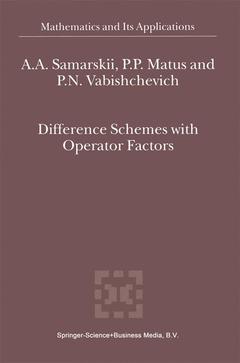Description
Difference Schemes with Operator Factors, Softcover reprint of hardcover 1st ed. 2002
Mathematics and Its Applications Series, Vol. 546
Authors: Samarskii A.A., Matus P.P., Vabishchevich P.N.
Language: English
105.49 €
In Print (Delivery period: 15 days).
Add to cart
Difference Schemes with Operator Factors
Publication date: 12-2010
384 p. · 15.5x23.5 cm · Paperback
Publication date: 12-2010
384 p. · 15.5x23.5 cm · Paperback
105.49 €
Subject to availability at the publisher.
Add to cart
Difference schemes with operator factors (POD)
Publication date: 08-2002
Support: Print on demand
Publication date: 08-2002
Support: Print on demand
Description
/li>Contents
/li>
Two-and three-level difference schemes for discretisation in time, in conjunction with finite difference or finite element approximations with respect to the space variables, are often used to solve numerically non stationary problems of mathematical physics. In the theoretical analysis of difference schemes our basic attention is paid to the problem of sta bility of a difference solution (or well posedness of a difference scheme) with respect to small perturbations of the initial conditions and the right hand side. The theory of stability of difference schemes develops in various di rections. The most important results on this subject can be found in the book by A.A. Samarskii and A.V. Goolin [Samarskii and Goolin, 1973]. The survey papers of V. Thomee [Thomee, 1969, Thomee, 1990], A.V. Goolin and A.A. Samarskii [Goolin and Samarskii, 1976], E. Tad more [Tadmor, 1987] should also be mentioned here. The stability theory is a basis for the analysis of the convergence of an approximative solu tion to the exact solution, provided that the mesh width tends to zero. In this case the required estimate for the truncation error follows from consideration of the corresponding problem for it and from a priori es timates of stability with respect to the initial data and the right hand side. Putting it briefly, this means the known result that consistency and stability imply convergence.
1. Introduction.- 2. Two-Level Difference Schemes.- 3. Difference Schemes with Operator Factors.- 4. Three-Level Difference Schemes.- 5. Three-Level Schemes with Operator Factors.- 6. Difference Schemes for Non-Stationary Equations.- 7. Schemes on Adaptive Grids.- 8. Difference Schemes of Domain Decomposition for Non-Stationary Problems.- References.
© 2024 LAVOISIER S.A.S.




